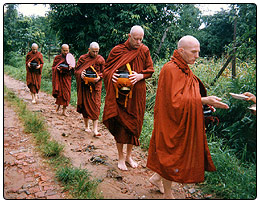
|

Monks on the daily alms-round
in Myanmar
|
Initially,
the monks and nuns travelled from place to place to teach,
stopping only during the period of the seasonal rains when
travelling was inconvenient. They followed the Buddha's instructions
to go forth on their separate ways to teach the Truth for
the good of many.
A
change, however, took place even during the Buddha's lifetime
when lay followers donated parks such as the Bamboo Grove
at Rajagriha and the Jeta Grove at Shravasti, to the Order
for their use. Having permanent places of residence for the
members of the Order had its advantages.
With
a permanent place available to them, the members of the Order
could hold discussions on the Teaching and instruct newcomers
to the Order. They also had more opportunities to interact
with the lay followers in order to instruct them in the Teaching.
Eventually,
these places of residence for the monastic community grew
into institutions, which had many facilities. They usually
included an assembly hall, a storeroom, a kitchen, toilet
facilities, as well as individual units for the members to
live in.
The
running of such large institutions required a number of administrative
officials whose duties included the distribution of food and
robes to the members of the Order. Within a few hundred years
of the Buddha's time, monasteries of this type were already
common. When Buddhism reached other countries in Asia, monastic
life continued to be an important part of the religion.